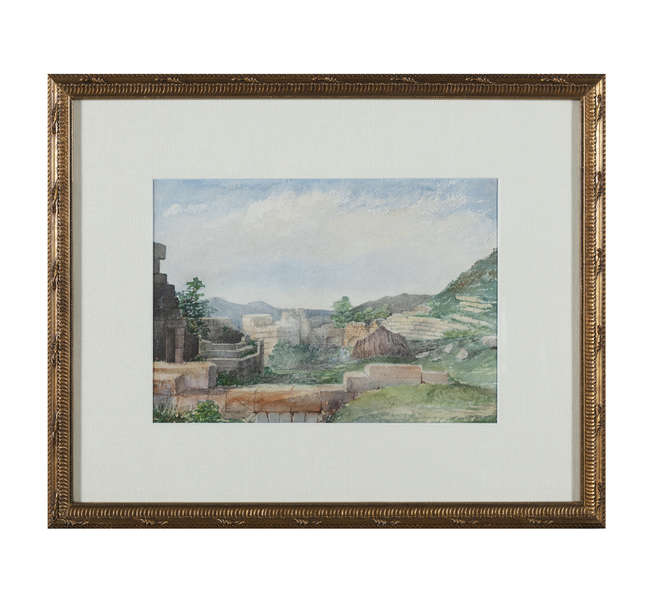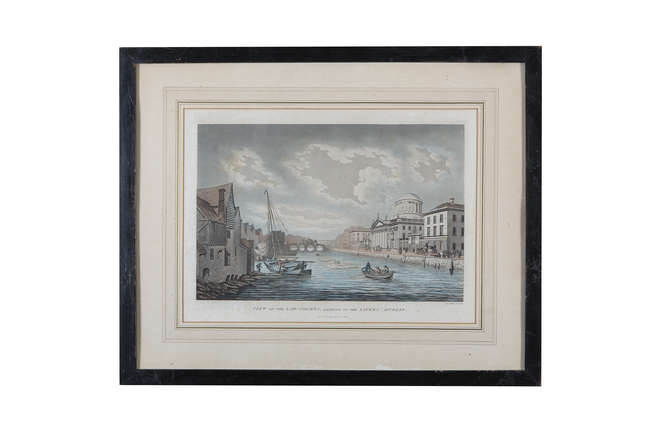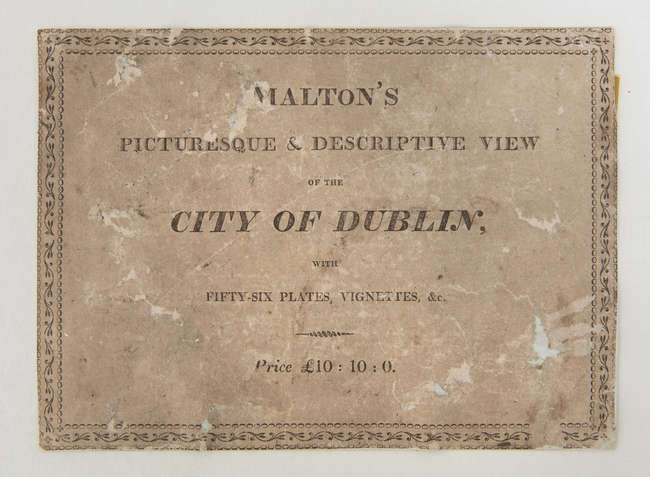JAMES MALTON (1761-1803) A set of twenty-five views of Dublin in hand coloured aquatints ''A Picturesque and Descriptive view of the City of Dublin'' Frames 30 x 42.5cm James Malton is thought to have lived in Dublin during the 1780s with his father Thomas Malton an architectural draughtsman and teacher. According to the Publius source he was apprenticed to James Gandon the famous architect, at the age of 17 in 1781. Malton's apprenticeship to Gandon was terminated after three years by mutual consent, after which he moved to London, working from there with frequent visits back to Dublin. Malton engaged on his grand project to produce his ''Picturesque Views of Dublin'', on a scale hitherto unknown even in London. Dublin pre-Act of Union in 1800 was of course an incredibly rich and vibrant city at the zenith of its financial and cultural powers, and so to Malton it must have appeared ripe for acceptance of such a publication to celebrate its status as the city second only to London. The book was published in six parts by subscription, as was the custom starting in 1792. The painting itself was carried out in London The book proved in part to be too great an undertaking for Malton, and he could not have foreseen the exodus which took place in the city after the Act of Union in 1800. He died in 1803 in London at the age of 38 of a brain fever, and undoubtedly did not reap the rewards of his endeavour. James Malton (1761-1803) undertook his Views of Dublin project in the 1780s and began to publish his set of twenty-five prints in 1792. Completed as an architecturally accurate depiction of Dublin, these prints served as a visual record for the city. The prints enlightened those living in the latter part of the 18th century as to the nature of Dublin and, to this day, they have maintained their importance as a captivating illustration of the city as it was. In 1796, St. Stephens Green, Dublin was published, providing a view stretching from the North West corner of the park, near what is now the Grafton Street entrance, towards Leeson Street. This idyllic and civilised portrayal of urban park life acts in direct juxtaposition to the areas previous history. The area of St. Stephens Green was so called on account of St. Stephens Church and its accompanying leper house that was founded in the vicinity c.1192. Until 1664, the Green itself consisted of a swampy stretch of land in which the locals could graze their livestock in between public executions and witch burnings. In order to reform this part of Dublin, an area of 27 acres was bordered off by lime trees with the surrounding plots of land being subject to housing development. Only those inhabiting these plots were granted access to the Green. During the next century, the Stephens Green area rose in popularity as the opening of Grafton Street (1708) and Dawson Street (1723) piqued the interest of fashionable individuals. As such, the park soon became a promenade of high society, with particular devotion being given to the Beaux Walk which ran along its northern edge. It is here that Malton has set his scene, portraying Dublin society at leisure. As ladies and gentleman pause for idle chatter, the viewer is encompassed by the lazy hum of their surroundings, whilst a pointing figure on the right directs our eye across the expanse of green, over a statue of George III by John van Nost and out to the city beyond. Rising in unison, these buildings are a stark reminder of Georgian solidarity and represent the building standards that were put on the Greens surrounding plots of land. With the passing of an Act of Parliament in 1814, we see St. Stephens Green warping slightly from Maltons depiction. Where once people could walk their dogs, these animals were now banned, along with such acts as running and jumping and any other exertion that might harm the land and the plants on it. This is all changed when, in 1880, Lord Ardilaun officially opened St. Stephens Green to the general public.
JAMES MALTON (1761-1803) A set of twenty-five views of Dublin in hand coloured aquatints ''A Picturesque and Descriptive view of the City of Dublin'' Frames 30 x 42.5cm James Malton is thought to have lived in Dublin during the 1780s with his father Thomas Malton an architectural draughtsman and teacher. According to the Publius source he was apprenticed to James Gandon the famous architect, at the age of 17 in 1781. Malton's apprenticeship to Gandon was terminated after three years by mutual consent, after which he moved to London, working from there with frequent visits back to Dublin. Malton engaged on his grand project to produce his ''Picturesque Views of Dublin'', on a scale hitherto unknown even in London. Dublin pre-Act of Union in 1800 was of course an incredibly rich and vibrant city at the zenith of its financial and cultural powers, and so to Malton it must have appeared ripe for acceptance of such a publication to celebrate its status as the city second only to London. The book was published in six parts by subscription, as was the custom starting in 1792. The painting itself was carried out in London The book proved in part to be too great an undertaking for Malton, and he could not have foreseen the exodus which took place in the city after the Act of Union in 1800. He died in 1803 in London at the age of 38 of a brain fever, and undoubtedly did not reap the rewards of his endeavour. James Malton (1761-1803) undertook his Views of Dublin project in the 1780s and began to publish his set of twenty-five prints in 1792. Completed as an architecturally accurate depiction of Dublin, these prints served as a visual record for the city. The prints enlightened those living in the latter part of the 18th century as to the nature of Dublin and, to this day, they have maintained their importance as a captivating illustration of the city as it was. In 1796, St. Stephens Green, Dublin was published, providing a view stretching from the North West corner of the park, near what is now the Grafton Street entrance, towards Leeson Street. This idyllic and civilised portrayal of urban park life acts in direct juxtaposition to the areas previous history. The area of St. Stephens Green was so called on account of St. Stephens Church and its accompanying leper house that was founded in the vicinity c.1192. Until 1664, the Green itself consisted of a swampy stretch of land in which the locals could graze their livestock in between public executions and witch burnings. In order to reform this part of Dublin, an area of 27 acres was bordered off by lime trees with the surrounding plots of land being subject to housing development. Only those inhabiting these plots were granted access to the Green. During the next century, the Stephens Green area rose in popularity as the opening of Grafton Street (1708) and Dawson Street (1723) piqued the interest of fashionable individuals. As such, the park soon became a promenade of high society, with particular devotion being given to the Beaux Walk which ran along its northern edge. It is here that Malton has set his scene, portraying Dublin society at leisure. As ladies and gentleman pause for idle chatter, the viewer is encompassed by the lazy hum of their surroundings, whilst a pointing figure on the right directs our eye across the expanse of green, over a statue of George III by John van Nost and out to the city beyond. Rising in unison, these buildings are a stark reminder of Georgian solidarity and represent the building standards that were put on the Greens surrounding plots of land. With the passing of an Act of Parliament in 1814, we see St. Stephens Green warping slightly from Maltons depiction. Where once people could walk their dogs, these animals were now banned, along with such acts as running and jumping and any other exertion that might harm the land and the plants on it. This is all changed when, in 1880, Lord Ardilaun officially opened St. Stephens Green to the general public.







Testen Sie LotSearch und seine Premium-Features 7 Tage - ohne Kosten!
Lassen Sie sich automatisch über neue Objekte in kommenden Auktionen benachrichtigen.
Suchauftrag anlegen